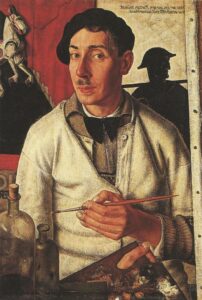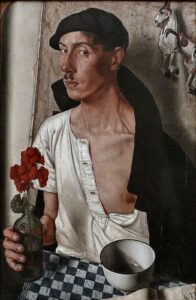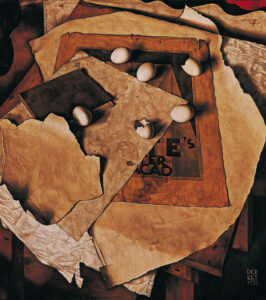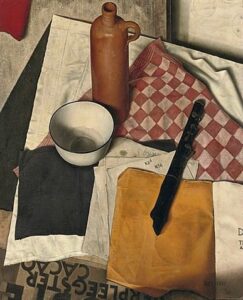by Valentina Biondini, art and literature amateur

Who’s Next? Dick Ket, a Dutch painter who is still surrounded by an aura of fascination both for his art and for his life, filled with irony and tragedy. His art and life are both like a beautiful feather fallen to the ground and suddenly blown away by the force of the wind. Initially influenced by Post-Impressionism, he later gravitated towards the Neue Sachlichkeit (New Objectivity) movement and, finally, to the so-called Magischer Realismus (Magic Realism).
Ket was born with a serious heart defect. Today, it is thought that the condition afflicting him may have been Tetralogy of Fallot, also known as Blue Baby Syndrome, which leads to progressive organ deterioration. After studying art at the Kunstöfening Arnhem Academy from 1922 to 1925, Dick, unfortunately, was no longer able to travel due to his illness. And, in particular from 1930 until his death in 1940, at the age of 38, he lived in reclusion with his parents in the city of Bennekom.

His pictorial production, focused on still lifes and self-portraits, includes a total of 140 paintings, most of which were created in the last ten years of his life. It is precisely with his portrait that Dick Ket opens one of the most touching chapters in his career, as many of his self-portraits reveal the progression of his illness, the most obvious symptoms of which are increasingly pronounced cyanosis and clubbed fingers. From 1933 to 1934, he achieved a certain amount of fame thanks to a solo exhibition, his first and unfortunately also his last, at the Kunstzaal van Lier in Amsterdam. His works are now exhibited at the Rijsmuseum of Amsterdam, the Gemeentemuseum in Amstelveen, and the Bojimans Van Beuningen Museum in Rotterdam. A curious fact: due to his technical experiments with mixing and formulating colors, some of his paintings are still not dry, even over 80 years!

It’s exactly from his home, Bennekom’s refuge and prison that, once the curtains of his studio window are pulled back, we seem to see his figure looking toward us. So let’s be silent and listen to what he has to tell us…
Welcome! This is how you welcome guests, isn’t it? I have doubts, because living cooped up here with only a few loved ones for company, I fear I’ve forgotten the polite expressions used in these situations. Now that you’ve arrived, I’ll open the door and try to remember how to welcome you in the manner befitting a gentleman.

Look around you, because for years now, my entire life has unfolded here, in this space of a few square meters. A silent life that slips through my fingers, and with those same fingers I stubbornly try to capture it on canvas so that not all is lost. Because life is short, yes, but art is long. Perhaps even eternal. So what do you think? Are my self-portraits truthful enough? Do you find that in real life my face, marked by the disease that has afflicted me since birth, corresponds to the one depicted in my paintings? I hope so, because I have not tried to hide the harshness of my illness, nor its inexorable evolution.

But don’t worry about me, I assure you that physical difficulties have not affected my spirit. I can truly say that my sense of humor and self-irony, my passion for art, my love of literature, music, cinema, puns, and mystery, have never left me. The illness has taken so much from me, it’s true, but it has also taught me something: to see the world in a grain of sand and to explore humanity through the company of myself and the few people I spend time with, namely, Schilt, my girlfriend and muse, and my father, who is also my best friend.

In other words, the life I’ve been given has stripped me of all the superfluous human experiences and left me with the essentials. This explains why my still lifes feature so few elements: bottles, an empty bowl, eggs, musical instruments, a bunch of grapes, newspaper clippings… Because a small part, even an infinitesimal one, is enough to glimpse the whole. So, for example, to represent water I don’t need to paint the sea, I simply spy its fall from a faucet into a bowl. And, ultimately, to explore the theme of humanity, I adopt the same technique: I simply seek the world within myself and in those few individuals who populate my existence. But now I must say goodbye. Art demands my presence and I can’t procrastinate any longer because my time is increasingly short by the hour…